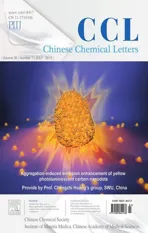Significant enhancement in water resistance of Pd/Al2O3 catalyst for benzene oxidation by Na addition
2019-07-27ShunyuKangMengWangNaZhuChunyingWangHuaDengHongHe
Shunyu Kang,Meng Wang,Na Zhu,Chunying Wang,Hua Deng*,Hong He,c
a Center for Excellence in Regional Atmospheric Environment, Key Laboratory of Urban Pollutant Conversion, Institute of Urban Environment, Chinese Academy of Sciences, Xiamen [21]361021, China
b University of Chinese Academy of Sciences, Beijing [2]100049, China
c State Key Joint Laboratory of Environment Simulation and Pollution Control, Research Center for Eco-Environmental Sciences, Chinese Academy of Sciences,Beijing [2]100085, China
Keywords:Sodium addition Pd/Al2O3 Benzene Water resistance Catalytic oxidation
A B S T R A C T A series of Na-doped 1 wt% Pd/Al2O3 catalysts with different Na loadings were prepared by wet impregnation and tested for the catalytic oxidation of benzene.Suitable addition of Na had a remarkable promotion effect on water resistance and enhancement of low temperature activity of Pd/Al2O3 catalysts.The optimal mole ratio between Na and Pd was 1:1. The properties of the prepared catalysts were characterized by X-ray diffraction (XRD), Brunauer Emmett Teller (BET), transmission electron microscopy (TEM), X-ray photoelectron spectroscopy (XPS), O2-temperature-programmed desorption(O2-TPD),and in situ DRIFTS.Results indicated that the addition of Na not only decreased the content of adsorbed water species but also increased the amount of liable surface oxygen species,which are likely the key factors for the excellent water resistance of the catalyst.Na addition also improved the mobility of the lattice oxygen species, which was favorable for catalytic activity. Moreover, the well-dispersed negatively charged Pd particles and suitable redox properties derived from Na addition also contributed to the improved performance and water resistance of the Na1Pd1/Al2O3 catalyst. In situ DRIFTS results revealed that benzene was oxidized to maleate and acetate species via intermediate o-benzoquinone species, which finally turned into harmless CO2 and H2O.
Volatile organic compounds (VOCs) are a major contributor to air pollution[1].Emissions of VOCs from industrial processes and transportation activities pose considerable harm to both the atmospheric environment and human health [2,3]. Therefore,VOCs abatement is an important pollutant control issue.
Catalyticoxidationisoneofthemosteffectivemeansforreducing VOCs emissions due to its high destruction efficiency, low NOx emissions,and minimal operation and energy costs[4],and has thus gained increasing interest[5–7].Noble-metal-based catalysts,such as platinum(Pt)[8–11],gold(Au)[12],and palladium(Pd)catalysts[13,14],are considered the most desirable candidates.Among them,Pd-based catalysts offer several advantages,including high activity,thermal stability, and low cost [13,15].As such, Pd-based catalysts have gained growing attention. For instance, Wang [25]et al. [16]established a highly active and anti-coking Pd-Pt/SiO2catalyst for theeliminationof tolueneatlowtemperature.Zhu[25]etal.[17]studied Al-doped TiO2mesoporous material supported by Pd for the complete oxidation of ethanol. Tang [25]et al. [18] reported on the promotion effect of acid treatment on Pd-Ni/SBA-15 catalysts for complete oxidation of benzene vapor.
Pd-based catalyst supports are highly important, with performance tightly related to support type[4].Al2O3,a porous support,is a desirable choice to load Pd, and has been investigated extensively for the catalytic oxidation of VOCs [13,15,19]. Huang [25]et al.[15]studied the complete oxidation of[26]o-xylene over Pd/Al2O3catalysts at low temperature and found Pd/Al2O3to be the most active among Pt and Au noble metal catalysts. Kim and Shim [13]investigated the catalytic oxidation of benzene, toluene, and o-xylene VOCs over a 1 wt% Pd/g-Al2O3catalyst and reported an activity order of o-xylene> toluene>benzene. Jiang [25]et al. [19]prepared a monolithic Pt-Pd bimetallic catalyst supported on g-Al2O3for catalytic combustion of benzene series, which achieved good catalytic combustion for benzene and other aromatic hydrocarbons. While the above research has obtained credible achievements,the influence of water vapor on the activity of catalysts has not been emphasized, which is inevitable in practical application. More importantly, the presence of water vapor may severely inhibit the operation of catalysts.
The alkali metal Na can serve as electronic or textural promoters for catalysts in various catalytic processes [20]. Haneda [25]et al. [21]have demonstrated good reactivity for NO decomposition over Co3O4with the addition of alkali metal Na. Li [25]et al. [20] reported that Na addition had a remarkable promotion effect on Pd/TiO2catalysts for HCHO oxidation.As for Soot abatement,Rao[25]et al.[22]have confirmed that Na addition is favorable for soot degradation over SnO2catalysts. Recently, we found the alkali metal Na is affirmative in enhancing water resistance and low temperature activity of Pd/Al2O3catalysts in the elimination of VOCs.
Herein,a series of Na-Pd/Al2O3catalysts with different Na to Pd mole ratios were prepared via wet impregnation.Benzene,a major and difficult-to-decompose VOC in the environment [13], was chosen as the model compound to test the effect of Na addition on the water resistance of Pd/Al2O3.The catalysts were characterized by means of X-ray diffraction(XRD),Brunauer Emmett Teller(BET),transmission electron microscopy (TEM), X-ray photoelectron spectroscopy(XPS),O2-temperature-programmed desorption(O2-TPD), and in situ DRIFTS. Results showed that Na addition had a remarkable promotion effect on water resistance and improved low temperature activity. The well-dispersed Pd particles, abundant liable surface oxygen species,and enhanced mobility of lattice oxygen species derived from Na addition contributed to the good performance in the elimination of VOCs.
We prepared 1 wt% Pd/Al2O3and Na-doped 1 wt% Pd/Al2O3catalysts, with different Na to Pd mole ratios of 1:1, 5:1, and 10:1,using wet impregnation.Four beakers filled with the same amount of deionized water were prepared. The same amount of g-Al2O3(5 g, SASOL, SBa-200) and 15% Pd(NO3)2solution (0.3325 g,Shanghai Jiu Ling Chemical Co., Ltd.) were then dissolved in the four beakers,respectively.Next,0.025,0.125,and 0.25 g of Na2CO3(Sinopharm Chemical Reagent Co.,Ltd.)were added into the three solutions separately. After stirring for 3 h, the excess water of the aforementioned mixed solution was removed in a rotary evaporator at 60C. To decompose the metal salt adsorbed on the Al2O3supports,the samples were dried at 100C overnight,then calcined in air at 500C for 3 h.After the prepared samples cooled to room temperature,they were crushed and sieved through 40–60 mesh.Prior to activity testing and characterization, the catalysts were pre-reduced at 300C for 1 h in mixed gas of 5 vol% H2and balanced N2at a total flow rate of 300 mL/min.Finally,we denoted 1 wt%Pd/Al2O3and Na-doped 1 wt%Pd/Al2O3catalysts with Na to Pd mole ratios of 1:1, 5:1, and 10:1 as Pd/Al2O3, Na1Pd1/Al2O3,Na5Pd1/Al2O3, and Na10Pd1/Al2O3, respectively.
To verify the credibility of this study, Na-doped Pd/Al2O3catalysts with Na and Pd mole ratios of 0.5:1,20:1,and 40:1 were prepared,as per above,and named Na0.5Pd1/Al2O3,Na20Pd1/Al2O3,and Na40Pd1/Al2O3, respectively.
The activity tests for the catalytic oxidation of benzene over Pd/Al2O3and Na-doped Pd/Al2O3catalysts were performed in a continuous flow fixed bed reactor.The catalyst(40–60 mesh)was supported on a small plug of glass wool in the middle of a straighttube quartz reactor. Before the activity tests, the catalysts were pretreated in mixed gas of 5 vol%H2and balanced N2at a total flow rate of 300 mL/min. The 1500 ppm benzene gas and 2 vol% water vapor were produced by a N2stream bubbling through a saturator filled with liquid benzene and water. The concentrations of benzene and water vapor were controlled by the flow rate of nitrogen or temperature of the water bath,which was kept at 36C.The reaction feed under dry conditions consisted of 1500 ppm benzene and 20 vol% O2in N2. We introduced 2 vol% water vapor into the mixed gas under wet conditions. The flow rate of the gas mixture through the reactor was 300 mL/min, corresponding to a gas hourly space velocity (GHSV) of 45,000 h1. The benzene concentration was analyzed online by a gas chromatograph (GC;Agilent 7890B, HP-5 capillary column) with a flame ionization detector.CO2and O2concentrations were analyzed by the same GC equipped with a thermal conductivity detector (Porapak Q and HayeSep Q column).
Powder XRD measurements were performed on an X’pert Pro instrument equipped with an X-ray source of Cu-Kα at a 2u angle ranging from 5to 90.Brunauer-Emmett-Teller(BET)surface area measurement was performed with N2adsorption/desorption isotherms on a Quantachrome QuadraSorb-evo system. TEM Images were obtained using a JEOL JEM-ARM2100 F with 200 kV acceleration voltage.XPS measurements were carried out with an ESCALAB250 spectrometer using a monochromatic Al Kα X-ray source (1486.6 eV). The binding energy was calibrated using the adventitious C 1s peak at 284.6 eV. The continuum spectra were fitted according to Gaussian-Lorentzian line shapes. The O2-TPD tests were carried out on a Micromeritics Autochem II 2920. The signals were monitored using an Ametek LC-D200 M PRO Mass Spectrometer. In situ DRIFTS spectra were recorded on a Thermo Fisher 50 Fourier transform infrared (FT-IR) spectrometer equipped with an in situ diffuse reflectance chamber (Harrick)and high sensitivity MCT/A detector.
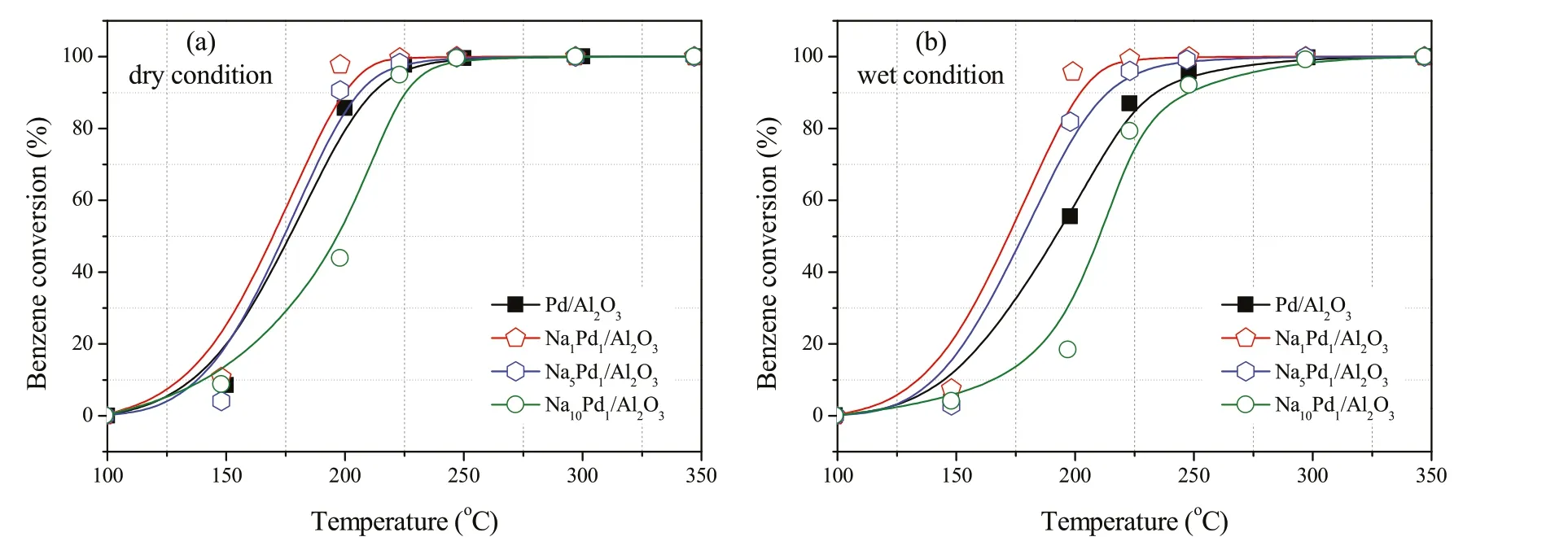
Fig.1. (a)Benzene conversion over Pd/Al2O3 catalysts under dry conditions.Reaction conditions:1500 ppm benzene,20 vol%O2,N2 balance,total flow rate=[18]300 mL/min,GHSV=45,000 h1.(b)Benzene conversion over Pd/Al2O3 catalysts under wet conditions.Reaction conditions:1500 ppm benzene,20 vol%O2,2 vol%water vapor,N2 balance,total flow rate = [18]300 mL/min, GHSV=45,000 h1.
The Na loading effect on 1 wt%Pd/Al2O3was examined in terms of benzene oxidation,with results shown in Fig.1.The conversion of benzene under dry conditions over different Na-doped Pd/Al2O3catalysts as a function of temperature is displayed in Fig.1a. The complete conversion temperature of Pd/Al2O3was about 210C.When an appropriate amount of Na was doped,the conversion of benzene over the whole range was improved slightly,and Na1Pd1/Al2O3exhibited the best performance.The conversion of benzene under wet conditions over different Na-doped Pd/Al2O3catalysts is shown in Fig.1b.Increasing the mole ratio from 0 to 5 significantly enhanced benzene conversion.Among them,Na1Pd1/Al2O3exhibited the highest benzene conversion,and the reaction temperature for>90%conversion(T90)was 196C.Increasing the mole ratio to 10 significantly decreased benzene conversion, indicating that there is an optimal amount of Na that can improve catalytic performance.
Comparison of benzene oxidation over the Pd-based catalysts is listed in Table S1(Supporting information).Our catalysts exhibited outstanding combined performance. The CO2selectivity curves over different Na-doped Pd/Al2O3catalysts are plotted in Fig. S1(Supporting information),which demonstrated the same trend as the conversion of benzene. As shown in Fig. S2 (Supporting information), suitable Na addition had a promotion effect on the Pd/Al2O3catalysts for benzene catalytic oxidation under both dry and wet conditions,and the optimal mole ratio between Na and Pd was 1:1.
To demonstrate the promotion effect of Na addition on water resistance of the Pd/Al2O3catalyst,durability tests for Pd/Al2O3and Na1Pd1/Al2O3were carried out at 215C, as shown in Fig. S3(Supporting information). It is clear that benzene conversion by Pd/Al2O3decreased from 96%to 90%when 2 vol%water vapor was introduced into the feed gas, however, benzene conversion by Na1Pd1/Al2O3was maintained at 97% at 215C, even after the introduction of water vapor.Comparison of the catalytic performances of Pd/Al2O3and Na1Pd1/Al2O3in dry and wet conditions is shown in Fig.S4(Supporting information).Thus,the introduction of water vapor significantly reduced the activity of Pd/Al2O3but demonstrated little impact on the Na1Pd1/Al2O3catalyst.
The result of XRD shown in Fig. S5 (Supporting information)suggests that the Pd species were dispersed better on the surface of the Na-doped g-Al2O3support than the undoped one.
The specific surface areas(SBET)and pore volumes(Vpore)of the catalysts listed in Table S2(Supporting information)together with the STEM images shown in Fig. S6 (Supporting information)indicate that excess Na addition may block some pore openings and then inhibit reactants in gaining access to the active sites in the pores, thus leading to the decrease in catalytic activity and water resistance over the Na10Pd1/Al2O3catalyst.
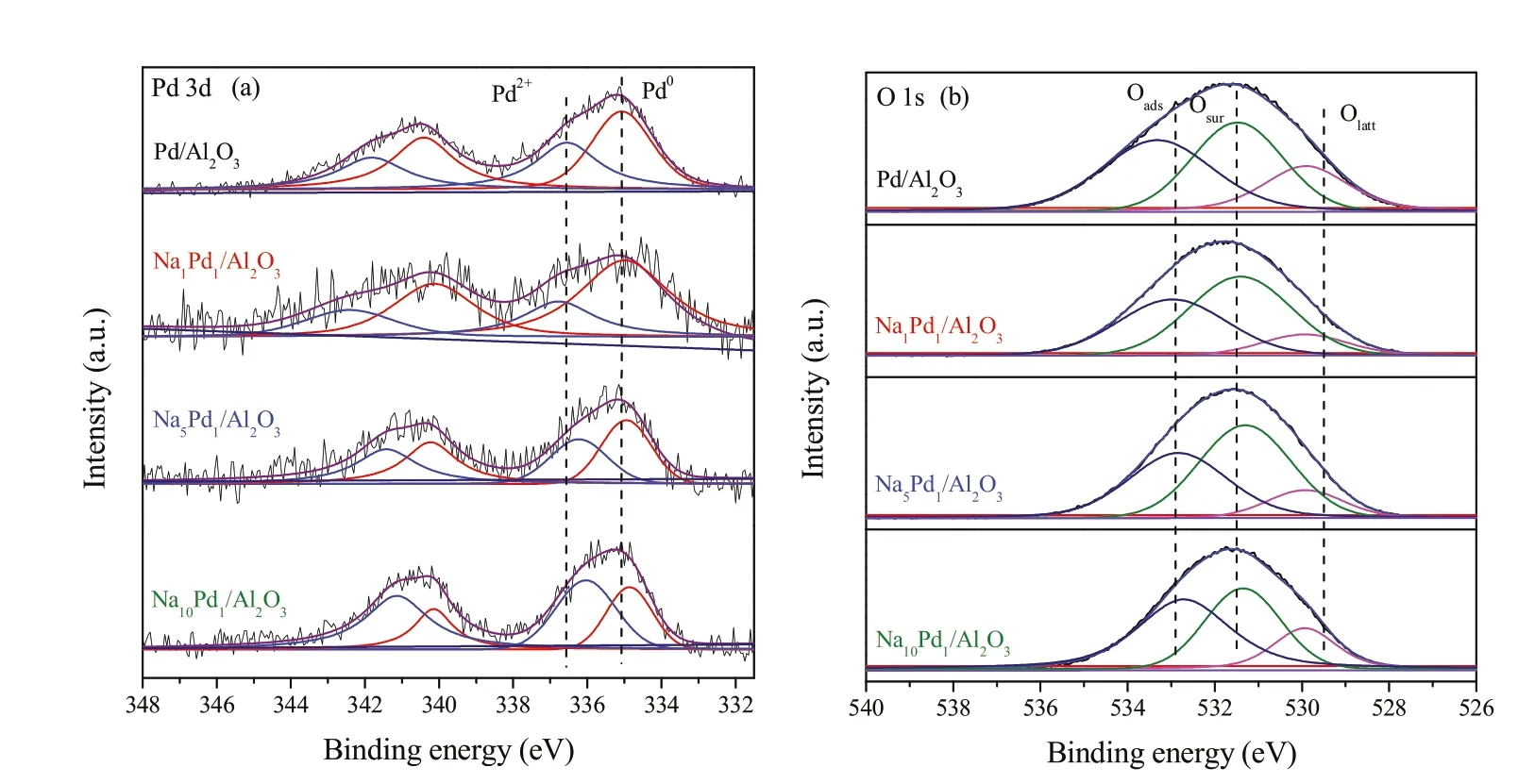
Fig. 2. XPS spectra of Pd/Al2O3 and Na-doped Pd/Al2O3 catalysts: (a) Pd 3d, (b) O 1s.
SEM-EDS of the as-prepared catalysts was shown in Fig. S7(Supporting information). It can be clearly seen that the percentages of weight for Pd of all the samples are around 1%,and the actual values of the Na to Pd mole ratios are close to the theoretical values.
The chemical states of the supported Pd and O species were characterized by XPS, with results shown in Fig. 2 and Table S3(Supporting information). As shown in Fig. 2a, the Pd 3d5/2peaks could be divided into two peaks with binding energies of 335.1 eV[23]and 336.4 eV[24],assigned to metallic Pd(Pd0)and oxidized Pd(Pd2+),respectively.It is worth noting that the binding energy of Pd0derived from the sample with Na addition slightly shifted to lower binding energy compared to Pd/Al2O3, revealing that electrons are donated from the Na species to metallic Pd due to promoter-metal interaction[25].Metallic Pd is more active than Pd oxide for total VOC oxidation [13,15]. As shown in Table S3, the relative content of Pd0was higher than that of Pd2+in all Na-related catalysts, except Na10Pd1/Al2O3, with Na1Pd1/Al2O3exhibiting the highest amount of Pd0. Thus, the performance of Na10Pd1/Al2O3was the weakest and the performance of Na1Pd1/Al2O3was the strongest.
Oxygen chemisorption can be enhanced by negatively charged metallic Pd species[26].Thus,the O 1s XPS spectra of the catalysts were investigated,as shown in Fig.2b.The O 1s spectra could be fit with three peaks at 529.9, 531.4, and 532.8 eV, which were assigned to lattice oxygen species (denoted as Olatt), surface adsorbed oxygen species(named as Osur),and chemisorbed water and/or dissociated oxygen and/or hydroxyl species (labeled as Oads),respectively[27,28].Due to the higher mobility,the adsorbed oxygen (Osur) was deemed to be more reactive during oxidation[29],thus the high relative contents of adsorbed oxygen(Osur) on the catalyst surface could be favorable for benzene removal. The specific peak positions and relative contents of different oxygen species are listed in Table S3.The relative contents of Olattand Oadswere decreased, whereas active Osurincreased for both Na1Pd1/Al2O3and Na5Pd1/Al2O3.This is consistent with the excellent water resistance of the Na1Pd1/Al2O3and Na5Pd1/Al2O3catalysts.Conversely,the relative content of Oadswas remarkably increased,whereas active Osurwas decreased for Na10Pd1/Al2O3.This may be one of the most important reasons why Na loading cannot be doped redundantly.In brief,the addition of Na plays a crucial role in tuning the relative content of different oxygen species, which eventually influences the activity to a great degree.The Na 1[27]s XPS was shown in Fig. S8(Supporting information). On increasing the initial Na loading, the surface sodium content was observed to increase substantially.
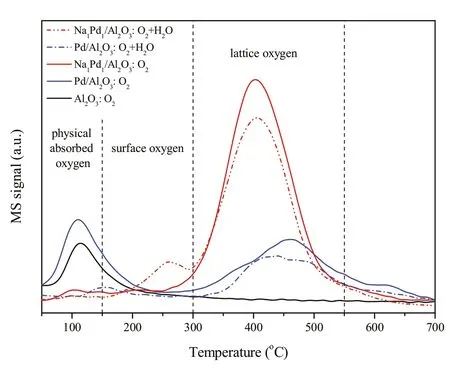
Fig. 3. O2-TPD profiles of Al2O3, Pd/Al2O3, and Na1Pd1/Al2O3 samples.
The O2-TPD experiments were performed over the samples to identify and confirm the activity and mobility of different oxygen species, with results shown in Fig. 3. The desorption peaks between 50–150C were ascribed to physical absorbed oxygen[30], the peaks obtained at 150–300C were attributed to the desorption of surface oxygen species such as O2and O[28][31],and the peaks above 300C were attributed to the evolution of lattice oxygen [32]. Compared with pure Al2O3, the Pd/Al2O3catalyst displayed an obvious lattice oxygen desorption peak, indicating that Pd doping promoted lattice oxygen mobility. When Na was introduced to Na1Pd1/Al2O3, the amount of physical absorbed oxygen was decreased, but the mobility of the lattice oxygen was enhanced, because the desorption regions for the lattice oxygen moved toward lower temperatures and the amount was dramatically increased. This result indicates that surface oxygen species are facilitated from bulk oxygen species [33]. Therefore, the oxidative property of the catalyst is reasonably improved,which is consistent with the catalytic performance. After water vapor was introduced to interact with the surface of the catalysts, the main desorption peak of lattice oxygen decreased for both Pd/Al2O3and Na1Pd1/Al2O3, indicating that the presence of water vapor deactivated the lattice oxygen species. However, a desorbed peak of surface oxygen species appeared from the Na1Pd1/Al2O3catalyst,indicating that the absorbed water can be transformed into liable surface oxygen, which is favorable for oxidation reaction activity[34]. These findings are consistent with the XPS-O1 s characterization and catalytic activity measurement results.
Based on these observations, the addition of Na not only improved the mobility of lattice oxygen, which helped facilitate redox reactions and enhance catalytic activity for benzene combustion,but also motivated the absorbed water to form liable surface oxygen species and promoted water resistance of the catalyst.
To elucidate the role of Na addition in the surface mechanism,in situ DRIFTS spectra were collected as a function of time in a mixture gas of benzene,O2,and water vapor at a fixed temperature of 200C,with the results illustrated in Fig.4.Exposure of the Pd/Al2O3and Na1Pd1/Al2O3catalysts to the feed gas resulted in the appearance of several peaks within the range of 1200–2500 cm1.In accordance with other reports, the board peak around 2361 cm1 was attributed to the asymmetric stretch of carbonate species [35].Thebandat1668 cm1wasassignedtotheC¼Ostretchingvibration of surface o-benzoquinone-type species [36]. The bands at 1575 cm1 and 1468 cm1 were assigned to the C¼C stretching vibrations of surface phenolate species[36].Bands corresponding to carboxylate species such as formate and acetate were detected at 1558,1450 and 1377(CH2stretching vibration) cm1 [15,37]. The bandat1312 cm1wasassignedtoasurfacemaleatespecies[38].As shown in Fig. 4a, as the reaction proceeded, the surface obenzoquinone-type species (1668 cm1), phenolate species(1575 cm1 and 1468 cm1), acetate species (1377 cm1), maleate species(1312 cm1)and CO2(2361 cm1)were gradually produced.Thus, it can be concluded that benzene was oxidized into obenzoquinone,phenolate,maleate,acetate species and CO2on the Pd/Al2O3catalystat 200Cinthepresenceofbenzene,O2,andwater vapor mixture.
In comparison to Fig. 4a, similar bands at 1688, 1377, and 1312 cm1 can be observed in Fig.4b as the reaction proceeded.A new band at 1558 cm1 corresponding to acetate species emerged.It is quite different to Pd1/Al2O3the surface phenolates species(1468 cm1)cannot be observed until 10 min later.Since phenolate species are very active and can be easily oxidized into benzoquinone [37], the presence of phenolate species indicated the exhaustion of the original liable surface oxygen species on the catalysts. The replenishment of gaseous oxygen to oxygen vacancies clearly decelerated the rate of oxidation. This finding indicates that Na1Pd1/Al2O3is more active than Pd/Al2O3.Moreover, the band intensities of surface organic species on Na1Pd1/Al2O3were relatively higher than that on Pd1/Al2O3,confirming that Na addition indeed promotes activity. The in situ DRIFTS spectra under both dry and wet conditions were compared and displayed in Fig. S9(Supporting information).Based on these results, a reaction mechanism was proposed and is displayed in Fig. S10 (Supporting information).
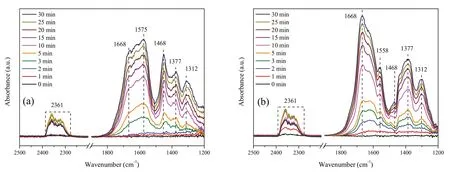
Fig.4. In situ DRIFTS of benzene oxidation over Pd1/Al2O3(a)and Na1Pd1/Al2O3(b)catalysts at different times.Reaction conditions:1500 ppm benzene,20 vol%O2,2 vol%water vapor, N2 balance, total flow rate = [19]100 mL/min, T = 200C.
The water resistance of the 1 wt% Pd/Al2O3catalyst during benzene oxidation was significantly promoted by the suitable addition of Na, with the Na and Pd mole ratio of 1:1 found to be optimal. The appropriate addition of Na led to the formation of well-dispersed and negatively charged metallic Pd particles,which facilitated oxygen adsorption. Proper Na addition promoted the transformation of absorbed water into liable surface oxygen species.In addition,the mobility of the lattice oxygen species was also significantly improved, which contributed to the enhanced catalytic activity and water resistance.
Acknowledgments
This work was supported by the National Natural Science Foundation of China(No.51608504),Youth Innovation Promotion Association, and Chinese Academy of Sciences (No. 2017064).
Appendix A. Supplementary data
Supplementarymaterialrelatedtothisarticlecanbefound,inthe online version,at doi:https://doi.org/10.1016/j.cclet.2019.03.023.
杂志排行
Chinese Chemical Letters的其它文章
- Sonochemical synthesis of silver nanoparticles coated copper wire for low-temperature solid state bonding on silicon substrate
- From interpenetrating polymer networks to hierarchical porous carbons for advanced supercapacitor electrodes
- Two alkynyl functionalized Co(II)-MOFs as fluorescent sensors exhibiting selectivity and sensitivity for Fe3+ and nitroaromatic compounds
- A novel mitochondria-targeting tetrapeptide for subcellular delivery of nanoparticles
- Oxidative CH alkynylation of 3,6-dihydro-2H-pyrans
- Hyperbranched polylysine:Synthesis,mechanism and preparation for NIR-absorbing gold nanoparticles
